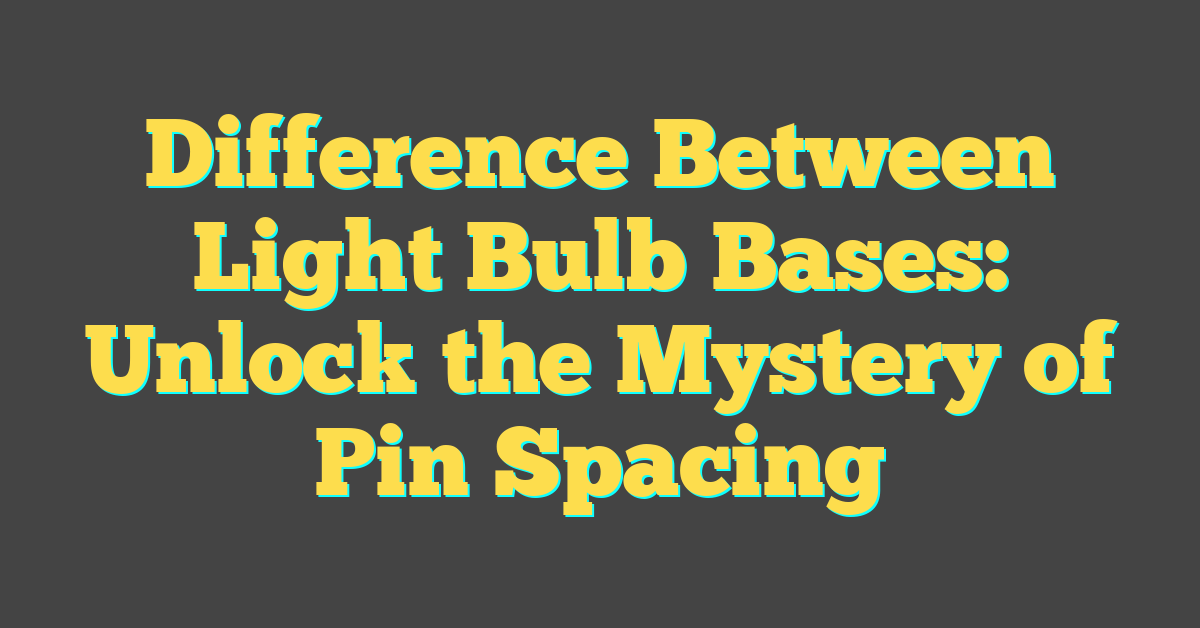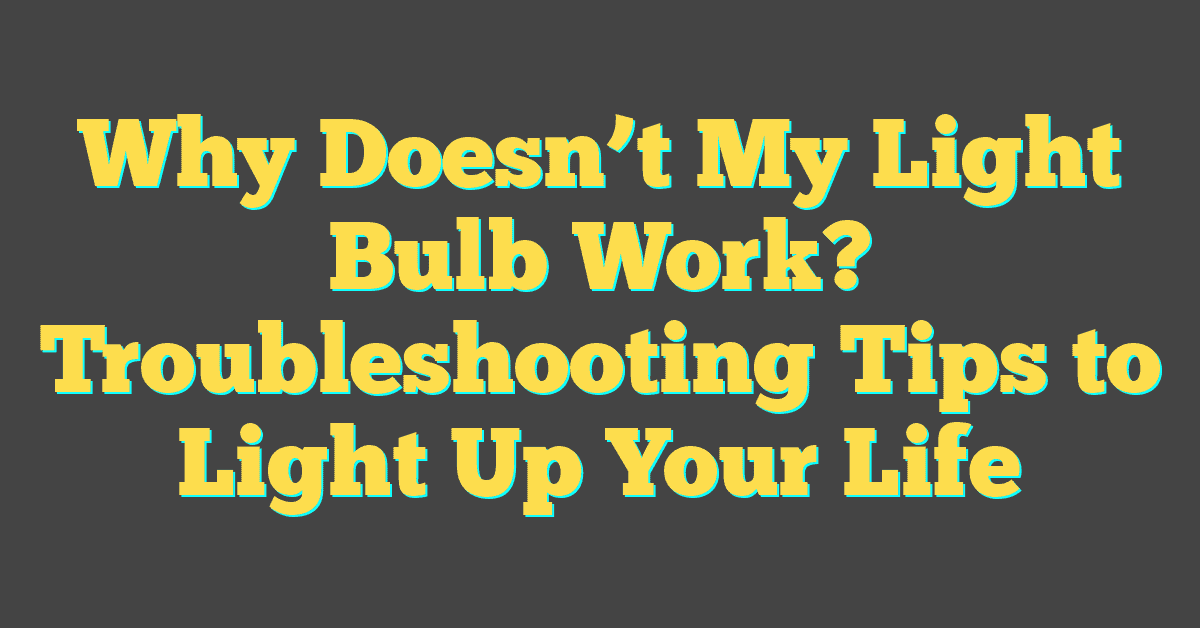Ever found yourself staring at an aisle of light bulbs, baffled by the variety of bases? You’re not alone. Choosing the right base is crucial for ensuring your bulb fits your fixture like a glove. Let’s shed some light on the subject, shall we?

From the classic screw-in bases to the two-pin bayonet styles, there’s a whole world beneath the glass. Understanding the difference can save you from the all-too-common trial and error routine at the hardware store.
Screw-In Bases
When you’re venturing into the world of home lighting, you’ll quickly find that screw-in bases are perhaps the most common and versatile option you have at your disposal. Edison screw is the term you’ll hear most often—it’s the standard base in North America and Europe.
There are several sizes within the Edison screw range:
- E12 – Often found in candelabra bulbs, these are dainty and elegant, ideal for smaller, decorative fixtures.
- E26 – This is your go-to standard or medium screw base, which fits most of the light fixtures in your home.
- E39/E40 – Known as mogul bases, these are larger and used in high-wattage, industrial applications.
Each base is unique not just in size but in its application and the type of bulb it can support. The E12, for instance, will generally support lower wattage bulbs. In contrast, E39/E40 bases are designed to handle high-intensity light sources needed in commercial or street lighting.
Don’t let the technical jargon discourage you; working with screw-in bases is straightforward. You simply match the base to the fixture—righty-tighty, lefty-loosey—and you’re set. However, ensuring compatibility between the light fixture and bulb base is critical for both safety and functionality.
Switching out bulbs or updating your lighting is a simple DIY project with screw-in bases. They’re user-friendly and allow for a quick change without needing specialized tools or equipment. Plus, with the prevalence of screw-in bases, finding a replacement or upgrade is rarely an issue.
Here’s a quick rundown of screw-in base sizes:
| Base Type | Common Name | Application |
|---|---|---|
| E12 | Candelabra Base | Decorative Fixtures |
| E26 | Standard Base | General Home Lighting |
| E39/E40 | Mogul Base | Industrial/Streetlight |
Bear in mind that certain energy-efficient bulbs, like LEDs, use traditional screw-in bases too, making them a breeze to introduce into your current lighting setup. As you explore various bulbs, take note of the vibe each brings. A warm, dimmable E12 bulb might be ideal for setting a cozy atmosphere, while a bright E26 LED can illuminate your workspace with ease.
Bayonet Bases

When you’re knee-deep in your next home DIY lighting project, it’s crucial to know your bayonet base bulbs as much as your screw-in ones. Bayonet bases are like the polite cousins of the Edison screw range – they click in place rather than twist. Recognized by their push-and-twist action, they’re super handy when you need a bulb that won’t shake loose, like in ceiling fans or outdoor fixtures.
You’ll come across the B22 base, which measures 22mm in diameter, most often. It’s a typical sight in many households, especially throughout the UK and former British colonies. Don’t be fooled, though; there’s also the B15 base, which is the smaller sibling at 15mm and often finds its place in more petite or decorative fixtures.
Here’s what you need to remember:
- B22 bases have two pins and a classic bayonet mount.
- B15 bases are similar but with a narrower profile.
Bayonet bases are designed for quick changes and a secure fit that stays firm even with vibration. They’re perfect in spots where a light bulb might get jostled. Plus, they’re a breeze to switch out—just push and twist, and you’re done.
What’s doubly interesting is that bayonet bases too can support a range of bulb types, including halogens and compact fluorescents. And yes, your energy-saving heroes, the LEDs, also come with bayonet fittings. But here’s where you need to be cautious – always check the fixture’s rating before popping in a new bulb. Wattage and voltage must align to avoid overheating or electrical issues.
« How Did Light Bulbs Impact the World: Illuminating Progress and Culture
How Are Light Bulbs Classified? The Ultimate Guide to Choosing the Right Bulb »
Using bayonet bases means thinking a bit on your feet. They’re not as ubiquitous as screw-in types, but for certain nooks of your home or particular lighting needs, they could be just the ticket. Be sure to keep a couple on hand – they have a knack for coming in useful when you least expect it.
Bipin Bases

Stepping into the realm of pin-type bases, you’ll find the bipin base as a significant player, especially when it comes to the world of speciality and certain residential lighting. These bases consist of two pins that plug into a socket, rather than screwing in or clicking into place. They’re incredibly efficient for securing the bulb to the fixture and providing a reliable electrical connection.
Bipin bases are particularly prevalent in more compact lighting solutions. G4, G9, GU10, and GU24 are just a few types that you might come across. These alphanumeric codes aren’t just random letters and numbers; they provide valuable information about the pin configuration. For instance, a G4 base means the pins are 4mm apart, while the GU10 base signifies that the pins have a 10mm distance between them and incorporate a twist-and-lock mechanism.
Here’s an insightful comparison of the common types of bipin bases:
| Base Type | Pin Distance | Locking Mechanism | Typical Use |
|---|---|---|---|
| G4 | 4mm | None | Under-cabinet lights |
| G9 | 9mm | None | Decorative chandeliers |
| GU10 | 10mm | Twist-and-lock | Directional spotlights |
| GU24 | 24mm | Twist-and-lock | Energy-efficient fixtures |
When you’re dealing with bipin bases, it’s essential to handle them with care because the pins can bend, which can mess with the installation. Moreover, always double-check the type needed for your fixture. You don’t want to end up with a G4 when you needed a GU10!
You’ll often find that bipin bases lend themselves well to halogens, LEDs, and fluorescents. Interestingly, these bases allow for a more precise alignment of the bulb within the fixture, which is critical for certain applications where directional light is key. It’s no surprise that you’ll spot bipin bases in spotlights, desk lamps, and even some kitchen and bathroom lighting fixtures. Their versatility doesn’t just end with the type of bulb they support but also extends to the sorts of environments they illuminate.
Bi-pin Fluorescent Bases

When dealing with fluorescents, you’ll often encounter the bi-pin base, a variation specifically designed for fluorescent tubes. These bases enable the tube to be securely held and receive power from its fixture. There’s a range of bi-pin types for various fluorescent sizes and power requirements. You’ve probably seen them in commercial settings or even your garage.
T8 and T12 bases are among the most prevalent in the bi-pin family. They’re named for the diameter of the fluorescent tube they fit; T8 being 1 inch in diameter and T12, 1.5 inches. These measurements aren’t random but rather represent the tube’s diameter in eighths of an inch. This standard sizing helps ensure you can easily find the right base and bulb combination for your project.
Let’s break down some key features:
- T8 bases are commonly found in modern, energy-efficient lighting fixtures.
- T12 bases, though less energy-efficient, are still used due to their abundant presence in older installations.
Don’t forget pin spacing. You can’t simply shove any bi-pin base into any fixture. For T8 and T12 fluorescent bases, the pin spacing standard is generally around 12.7mm (0.5 inches), which is crucial for a proper fit. If the spacing isn’t right, the connection won’t be secure, or worse, you could damage your fixture or bulb.
| Fluorescent Base | Diameter | Pin Spacing |
|---|---|---|
| T8 | 1 inch | 12.7mm |
| T12 | 1.5 inch | 12.7mm |
Handling these bases requires a careful touch. When you’re installing or replacing your fluorescent tubes, it’s best to hold them near the base to minimize the risk of bending the pins or breaking the tube. Always ensure the power is off before you start work. Safety first, right?
Understanding bi-pin fluorescent bases enhances your ability to work on a range of lighting projects. With the right knowledge, you can upgrade those flickering lights in the basement or install efficient fixtures in your workshop. The satisfaction of illuminating your space with your own hands is unmatched. Keep this information in your DIY toolkit and you’ll brighten up more than just a few bulbs.
Conclusion
You’ve got the scoop on bi-pin bases now and how crucial they are for your fluorescent lighting needs. Remember, it’s all about the pin spacing to ensure a snug fit without any hiccups. So next time you’re swapping out a tube or planning a lighting project, you’ll know exactly what to look for. Here’s to brightening up your space with the perfect glow!
Frequently Asked Questions
What is a bi-pin base for light bulbs?
A bi-pin base is a type of socket arrangement for light bulbs that uses two pins to secure the bulb in place and provide an electrical connection.
What are the common types of bi-pin bases for fluorescent tubes?
The most common types of bi-pin bases for fluorescent tubes are T8 and T12, which are named after their diameters measured in eighths of an inch.
Why is pin spacing important for bi-pin bases?
Pin spacing is crucial for ensuring a proper fit in the light fixture and avoiding damage to both the fixture and the bulb.
Can incorrect bi-pin base handling damage the bulb or fixture?
Yes, incorrect handling or choosing the wrong bi-pin base can result in damage to the bulb or fixture.
What are the benefits of understanding bi-pin bases?
Understanding bi-pin bases is beneficial for ensuring correct installation, maintenance, and safe handling of fluorescent tubes and for making informed decisions for lighting projects.




